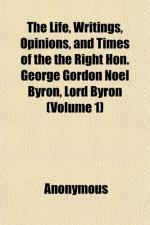|
This section contains 4,963 words (approx. 17 pages at 300 words per page) |

|
SOURCE: "Masses and Solids: Byron's View of the External World," in Modern Language Quarterly, Vol. 35, No. 3, September, 1974, pp. 257-71.
In the essay below, Bostetter examines Byron's ideas regarding the relationship of the human mind and the physical world as expressed in his poems.
John Locke's theories affected all the major Romantics, even those like Coleridge who repudiated them with such scorn. In particular, they were influenced by his separation of senses into primary and secondary sensations, the external world versus the inner world. The distinctions Locke drew were simple and dramatic: the "primary" qualities of objects—solidity, extension, figure, motion or rest, and number—are those that really exist in the objects, whether anyone's senses perceive them or not; and secondary qualities—colors, sound, tastes, etc.—"in truth are nothing in the objects themselves but powers to produce various sensations in us by their primary qualities, i.e...
|
This section contains 4,963 words (approx. 17 pages at 300 words per page) |

|


